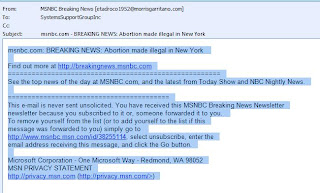
There has been a noticeable uptick in dangerous emails over the last couple of months. Most recently, a bunch of CNN Top 10 emails that have malicious links in them. Yesterday we started seeing MSNBC News Alerts emails with the same type of malicious links. And we are even seeing bogus Internet Explorer update emails.
The common thing about these emails, with the exception of the IE update one, is they look very genuine right down to the company logos and fancy email layouts. This is all designed of course to trick the reader in to clicking on a link in the message that will cause some type of harm to their system.
Users need to be reminded about the potential problems with email and need to be alert when they see something like one of these emails. Do they have a subscription to CNN Top 10? Even if they do, check the from address in the message, most of the bogus messages we see will be very obvious by the strange from address names. Is the message signed by a famous person or some high ranking official from a foreign country?
Most users are aware of potential problems with email attachments. However, we find that most users are totally unaware of the same, if not increased risk of clicking on links in emails. As business owners and managers we must be aware of these risks and take whatever steps we can to mitigate them. One of the first steps (after making sure you have current antivirus and anti spyware software installed), is to create a process for continually educating and reminding your users of the potential risks within emails and bogus or infected websites. How do you handle this issue? Leave a comment here about how you are fighting or intend to fight this problem.